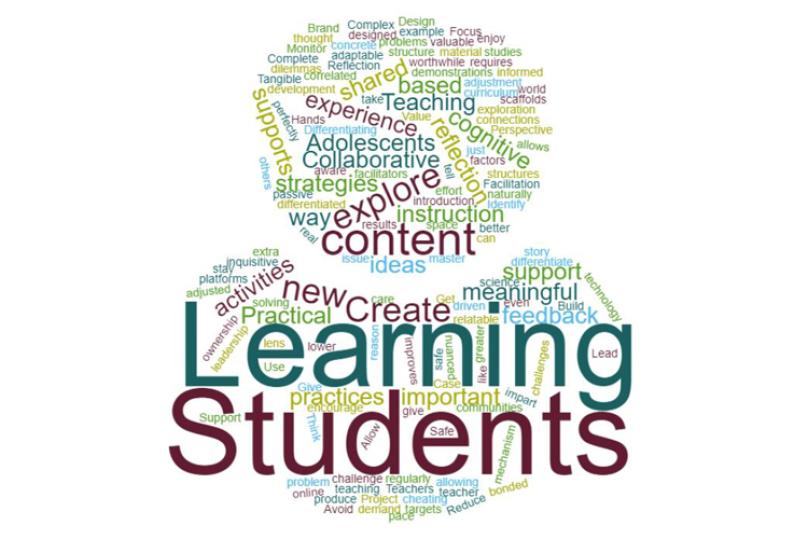
By Dennis John, MƒA Director of Research
My motivations for writing a research blog post are twofold. First, I fundamentally believe that research should not be secretive; it should not exist in the shadows only to surface through annual reports or the occasional bar graph. Instead, research at MƒA is ongoing and should continue to be transparent in its goals, processes, and findings. Second, I think research should be pursued as a co-creative process. We seek compelling stories about our fellowship community and look to contribute to the public dialogue about the profession of teaching. We also want to engage our teachers as thought partners to help drive dialogue and uncover both the intrinsic and tangible value of MƒA experiences to teachers’ professional lives. In this way, research at MƒA is rooted in learning about our teacher community to identify areas for reflection and indicators of success of our fellowship model. I hope this piece supports and embodies this approach and serves as an yet another example of our respect for teachers, our commitment to designing experiences that support their interests, and our efforts to recognize the power of teacher communities.
To start, I’d like to revisit a question I asked in the first days of beginning my job at MƒA over a year ago: “What makes this place so special?”
This was the central question I asked myself, fellow staff members, and teachers. I grappled with this question a great deal in those first few weeks, though not because I couldn’t gather compelling answers from those who I was talking to. Rather, the responses I was getting from teachers and staff alike were joyfully diverse, yet in ways that were complementary and interconnected. This presented a compelling challenge for research as we sought to dive into these intricacies and identify the unique elements that underscore positive teacher experiences within the MƒA community.
An opportunity for me to learn more presented itself in the form of our Summer Think Conference. Last year, more than one hundred MƒA teachers came together for this first ever teacher-led conference. Just prior to the beginning of the conference, I met with Leah Hirsch, MƒA Director of Professional Development, and the conference planning committee to design a survey that aligned with the Summer Think goals of helping the teachers who came expand on their identity and sense of belonging within MƒA.
Through the responses we received from this survey, as well as many one-on-one conversations and my own observations during conference sessions, I learned that our teachers’ professional identities are inextricably linked to their own learning, the opportunities for shared learning among peers, and the ways their students are given opportunities to understand the value of learning. Comments like, “Collaborative [student] learning doesn't encourage cheating,” “Students should be aware of a greater reason to why we should care about science,” and “Safe, bonded communities can produce better results” supported this sentiment and together formed a purposeful, collective interest in learning. More importantly, there is an implicit focus on identifying the “why” or purpose of learning for both teachers and students.
This teacher-peer-student partnership was woven throughout survey feedback. In particular, applying an empathetic ear to different forms of student learning resonated strongly among teachers, with several participants asserting a need for creative pedagogical approaches to support the application of complex content. Calls to “Avoid passive activities” and “Create structures to explore problems” captured a common feeling that teachers desired collaborative growth in a way that pins together peer and student learning. That such a cooperative mindset could bond together learning among teachers and their students stood out to me as a unique product of the MƒA community and gave me my first glimpse into answering the question: “What makes this place so special?” This glimpse would also foretell enthusiasm for the 2018 Summer Think Conference. In its second year, the conference once again drew a diversity of teachers together over the summer to tackle important topics (see below). Afterwards, 92% of teachers reported they plan to share what they learned with colleagues within the same department/content area at their school. Further still, the most successful reported conference sessions were those that clearly connected techniques and strategies that carried concrete implications across individual learning/growth, peer/group learning, and student learning in the classroom.

Even after what I learned from documenting and participating in the MƒA Summer Think, I readily admit that teacher-peer-student partnerships aren’t the only characteristics of professional learning communities that make them effective and help to reverse or slow down current industry challenges like teacher attrition. It’s fair to say that to fully answer the question, “What makes this place so special?” it will require further learning. However, I do know that teachers learn best when they learn from one another, and I would be remiss to argue that such connections aren’t important contributors to the MƒA experience.
In my short time here, I have learned that the value of peer communities in its influence on teacher professional growth and (ultimately) student learning is, in part, by virtue of the professional autonomy and accountability such collectives afford its participants. The task now is to map a path forward that allows us to further explore the depth of feedback we receive on a regular basis from the community of MƒA teachers that can build upon the nuanced findings of the Summer Think experience. In doing so, we create opportunities to partner together to learn and grow. This co-creation is what "research" sets out to do and I am excited for the learning ahead.
